Alsephina, Delta Velorum Aa (δ Vel Aa), is the primary component in a triple star system located in the southern constellation Vela. It is a white subgiant star in a spectroscopic binary system that lies about 80.6 light years away. With a combined apparent magnitude of 1.96, the Delta Velorum system is the second brightest point of light in Vela, after Regor (Gamma2 Velorum). Alsephina is one of the four bright southern stars that form the False Cross, an asterism often mistaken for the better known Southern Cross.
Star system
Delta Velorum is a triple star system composed of a spectroscopic binary pair designated Delta Velorum A and a fainter companion, Delta Velorum B. The components A and B orbit each other with a period of 143.2 years. On average, they are separated by 1.996 arcseconds on the sky, which corresponds to a physical separation of 90.61 astronomical units. The stars have an eccentric orbit and the observed separation between them was only 0.6 arcseconds in 2013.
The components of Delta Velorum A form an eclipsing binary system whose brightness varies from magnitude 1.99 to 2.39. The stars have an orbital period of 45.1503 days and are separated by only 0.01651 arcseconds. They eclipse each other as they orbit, causing the system’s brightness to vary.
Delta Velorum A was first resolved using speckle interferometry in 1978 and confirmed as a spectroscopic binary in 1997 based on the data obtained with the Hipparcos satellite. The system was reported to be an eclipsing binary in 2000.
The primary component, Delta Velorum Aa (formally known as Alsephina), is a white subgiant of the spectral type A2IV. It has a mass 2.43 times that of the Sun and a radius 2.79 – 2.97 times solar. With an effective temperature of 9,440 K, it is 67 times more luminous than the Sun. The star is a fast spinner. With a projected rotational velocity of 143.5 km/s, it completes a rotation in 1.05 days.
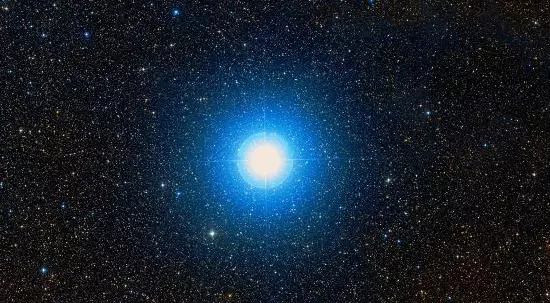
Alsephina (Delta Velorum), image: Wikisky
The companion, Delta Velorum Ab, has the stellar classification A4V, indicating a white main sequence star. It is slightly smaller and less massive than Alsephina, with a mass of 2.27 solar masses and a radius 2.37 – 2.52 times that of the Sun. It shines with 51 solar luminosities with an effective temperature of 9,830 K. Like its close companion, Delta Velorum Ab is a fast rotator, spinning at 149.6 km/s. The star’s estimated age is 400 million years.
As a result of their fast rotation rates, both stars have oblate shapes, with their equatorial radii larger than their radii at the poles. Alsephina has a polar radius of 2.79 R☉ with a temperature of 10,100 K and an equatorial radius of 2.97 R☉ with a temperature of 9,700 K. Delta Velorum Ab has a radius of 2.37 R☉ at the poles with an effective temperature of 10,120 K and 2.52 R☉ at the equator with a temperature of 9,560 K. The temperatures and luminosities are higher at the poles because, in oblate stars, the poles are closer to the centres of mass.
Delta Velorum B lies almost two arcseconds away from the main pair. It is a white main sequence star of the spectral type F8 V. It is smaller, cooler, and much less luminous than the components Aa and Ab. It has a mass between 1.35 and 1.46 solar masses and a size of 1.4 solar radii. With a surface temperature of 6,600 K, it shines with 3.5 solar luminosities. It is considerably fainter than Delta Velorum A, shining at magnitude 5.54.
The Delta Velorum system likely has another co-moving companion. The star HD 76653 lies 2.2 light years away from the system and has a similar proper motion. It is a white main sequence star of the spectral type F6 V, shining at magnitude 5.71. The space velocities of both the Delta Velorum components and HD 76653 indicate that they are members of the Ursa Major moving group.
Two other stars are sometimes referred to as Delta Velorum C and D, but they are now believed to not be physically related to Alsephina. They form a binary pair and appear 69 arcseconds away. The components are separated by 6 arcseconds. Both are main sequence stars (of spectral types G8V and K0V) and invisible to the unaided eye. They are believed to lie at a greater distance than Delta Velorum.
Facts
Alsephina is one of the four bright stars that form the False Cross, an asterism often confused for the brighter and smaller Southern Cross. The other three stars of the False Cross are Markeb (Kappa Velorum) in the constellation Vela and Avior (Epsilon Carinae) and Aspidiske (Iota Carinae) in Carina. Alsephina is the second brightest of the four stars, after Avior.
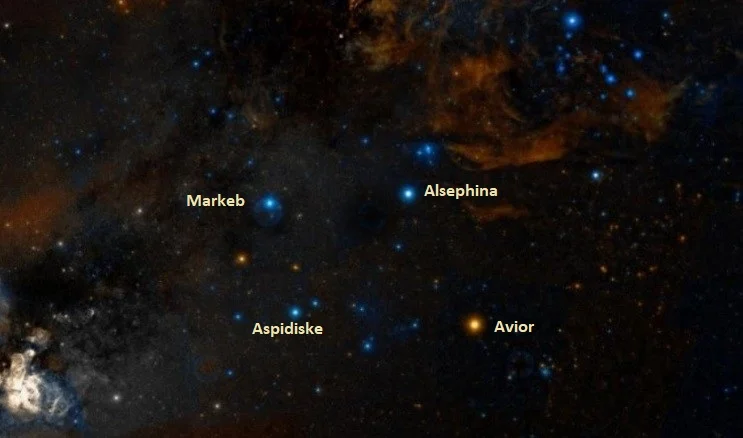
The False Cross, image: Wikisky
Delta Velorum will be the southern pole star around the year 9200. The south celestial pole will pass through the False Cross in the 80th and 90th centuries and Alsephina will be preceded by Aspidiske, which will take its turn as the South Star in the year 8100. Both stars will be much more useful in navigation than the current South Star, Sigma Octantis (Polaris Australis), which is barely visible at magnitude 5.47 and located in a faint, indistinctive constellation (Octans).
Name
The name Alsephina (pronunciation: /ælsɪˈfaɪnə/) comes from the Arabic al-safīnah, meaning “the ship.” The name refers to Argo, the mythical ship on which Jason and the Argonauts sailed to Colchis to find the Golden Fleece. In Greek mythology, the ship was named after its builder Argus, who constructed it with the help of the goddess Athena. The name first appeared in an Arabic translation of Ptolemy’s Almagest in the 10th century. At the time, it referred to the entire constellation Argo Navis (the Ship Argo), but was later assigned to Delta Velorum. The Dutch-German cartographer Andreas Cellarius used it for the star in his star atlas Harmonia Macrocosmica, published in 1660.
The name was approved by the International Astronomical Union’s (IAU) Working Group on Star Names (WGSN) on September 5, 2017. It only applies to the component Delta Velorum Aa.
In Chinese astronomy, Delta Velorum is known as 天社三 (Tiān Shè sān), the Third Star of Celestial Earth God’s Temple. It forms the asterism called Celestial Earth God’s Temple with Regor (Gamma2 Velorum), Markeb (Kappa Velorum), b Velorum, Phi Velorum, and N Velorum. The asterism is part of the larger Ghost mansion, one of the southern mansions of the Vermilion Bird.
Location
Alsephina is easy to find because it is bright and part of a conspicuous southern asterism, the False Cross. The False Cross is one of three diamond-shaped asterisms in the far southern sky. It is larger and fainter than the better-known Southern Cross in the constellation Crux, but brighter than the nearby Diamond Cross in Carina.
The easiest way to distinguish between the Southern Cross and the False Cross is to look for the Southern Pointers – Alpha Centauri and Hadar – which point toward the Southern Cross. The False Cross lies closer to Canopus, the second brightest star in the sky, which does not have any exceptionally bright neighbours.
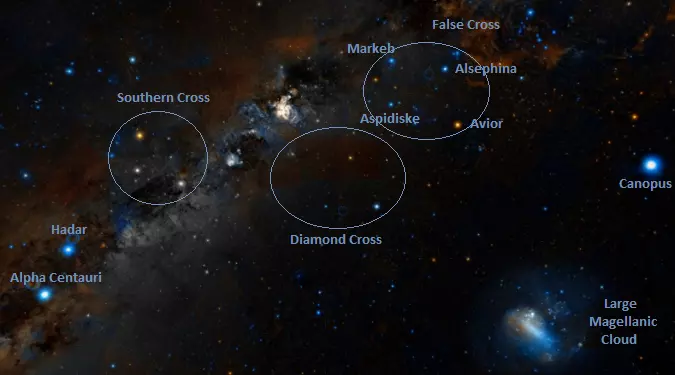
The location of Alsephina, Avior, Markeb and Aspidiske, image: Wikisky
Alsephina can be used to find the Omicron Velorum Cluster (IC 2391), a bright, large open cluster that lies just north of the star. With an apparent magnitude of 2.5, the cluster is visible to the unaided eye. It occupies an area of 50 arcminutes of the apparent sky. Its central member, Omicron Velorum, is a slowly pulsating blue subgiant star (B3 IV) with a visual magnitude of 3.60. The cluster lies approximately 574 light years away.
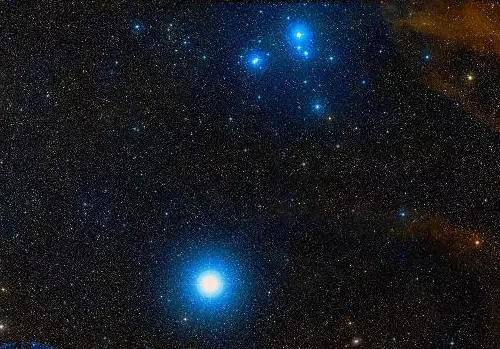
Alsephina and the Omicron Velorum Cluster (IC 2391), image: Wikisky
Constellation
Alsephina is located in the southern constellation Vela. Vela represents the sails of the ship Argo, on which Jason and the Argonauts sailed to Colchis to retrieve the Golden Fleece. It was once part of the larger Greek constellation Argo Navis (the ship Argo) along with the neighbouring Carina and Puppis. Argo Navis was divided into three constellations – Carina (the keel), Puppis (the stern) and Vela (the sails) by the French astronomer Nicolas-Louis de Lacaille in the 18th century.
Vela is the 32nd largest constellation in the sky, stretching across an area of 500 square degrees. Its brightest star, Regor, is the closest Wolf-Rayet star to the Sun. With five stars brighter than magnitude 3.00, Vela is one of the more conspicuous southern constellations.
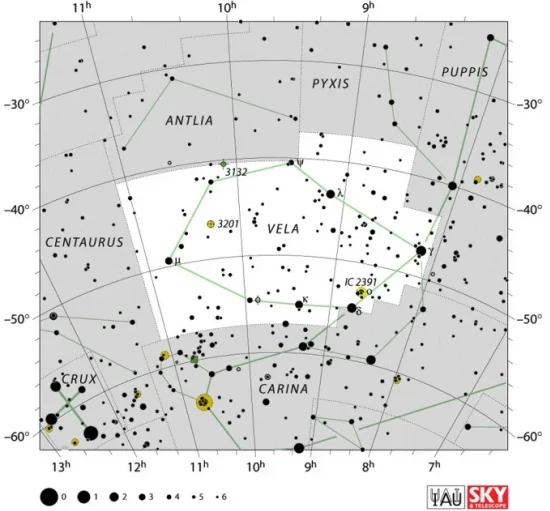
Vela constellation map by IAU and Sky&Telescope magazine
In addition to Alsephina and Regor, interesting stars in the constellation include the variable orange supergiant Suhail (Lambda Velorum), the Cepheid variable AH Velorum, the blue subgiant Omicron Velorum, the brightest star in the Omicron Velorum Cluster, and the binary brown dwarf Luhman 16, the third closest star system to the Sun.
Notable deep sky objects in Vela include the emission nebulae Gum 12 (the Gum Nebula) and Gum 20, the planetary nebulae NGC 2899 and the Eight-Burst Nebula (Southern Ring Nebula, NGC 3132), the open clusters NGC 2670, NGC 2547 and IC 2391 (the Omicron Velorum Cluster), the globular cluster NGC 3201, and the peculiar galaxy NGC 3256. The Gum Nebula hosts the Vela Supernova Remnant, a remnant of a Type II supernova that occurred between 11,000 and 12,300 years ago.
The best time of year to observe the stars and deep sky objects in Vela is during the month of March, when the constellation is prominent in the evening sky. The entire constellation is visible from locations between the latitudes 30° N and 90° S.
The 10 brightest stars in Vela are Gamma2 Velorum (mag. 1.83), Alsephina (Delta Vel, mag. 1.96), Suhail (Lambda Vel, mag. 2.21), Markeb (Kappa Vel, mag. 2.48), Mu Velorum (mag. 2.69), N Velorum (HD 82668, mag. 3.16), Phi Velorum (mag. 3.53), Omicron Velorum (mag. 3.60), c Velorum (HD 78004, mag. 3.75), and b Velorum (HD 74180, mag. 3.81).
Delta Velorum
| Spectral class | A2IV + A4V + F8V |
| Variable type | Eclipsing binary (Delta Velorum A) |
| U-B colour index | +0.07 |
| B-V colour index | +0.04 |
| Apparent magnitude | 1.96 |
| Absolute magnitude | 0.02/3.60 |
| Distance | 80.6 ± 0.8 light years (24.7 ± 0.2 parsecs) |
| Parallax | 40.49 ± 0.39 mas |
| Radial velocity | +2.20 ± 1.78 km/s |
| Proper motion | RA: +28.99 ± 0.50 mas/yr |
| Dec.: -103.35 ± 0.54 mas/yr | |
| Constellation | Vela |
| Right ascension | 08h 44m 42.22658s |
| Declination | −54° 42′ 31.7493″ |
| Names and designations | Delta Velorum, δ Vel, HD 74956, HR 3485, HIP 42913, SAO 236232, GC 12069, GCRV 5781, PPM 337198, PLX 2098, JP11 1716, UBV 8508, IRAS 08433-5431, 2MASS J08444223-5442313, CD-54 2351, AAVSO 0842-54, CCDM J08448-5442AB, WDS J08447-5443AB |
Delta Velorum A
| Spectral class | A2IV + A4V |
| Variable type | Eclipsing binary |
| Apparent magnitude | 2.00 (1.99 – 2.39) |
| Proper motion | RA: 28.8 ± 0.4 mas/yr |
| Dec.: -104.1 ± 0.4 mas/yr | |
| Right ascension | 08h 44m 42.226383s |
| Declination | −54° 42′ 31.75567″ |
| Names and designations | Delta Velorum A, δ Vel A, Delta1 Velorum, δ1 Vel, TYC 8573-3571-1, CCDM J08448-5442A, IDS 08419-5420 A, WDS J08447-5443A, WDS J08447-5443Aa,Ab |
Alsephina – Delta Velorum Aa
| Spectral class | A2IV |
| Mass | 2.43 M☉ |
| Luminosity | 67 L☉ |
| Radius | 2.79 – 2.97 R☉ |
| Temperature | 9,440 K |
| Metallicity | -0.33 dex |
| Rotational velocity | 143.5 km/s |
| Rotation | 1.05 days |
| Surface gravity | 3.78 – 3.90 cgs |
Delta Velorum Ab
| Spectral class | A4V |
| Mass | 2.27 M☉ |
| Luminosity | 51 L☉ |
| Radius | 2.37 – 2.52 R☉ |
| Temperature | 9,830 K |
| Age | 400 million years |
| Rotational velocity | 149.6 km/s |
| Surface gravity | 3.99 – 4.10 cgs |
Delta Velorum B
| Spectral class | F8V or F7.5V |
| Apparent magnitude | 5.54 |
| Mass | 1.35 – 1.46 M☉ |
| Luminosity | 3.5 L☉ |
| Radius | 1.43 R☉ |
| Temperature | 6,600 K |
| Right ascension | 08h 44m 42.202745s |
| Declination | −54° 42′ 30.60235″ |
| Names and designations | Delta Velorum B, δ Vel B, Delta2 Velorum, δ2 Vel, TYC 8573-3571-2, CCDM J08448-5442B, IDS 08419-5420 B, WDS J08447-5443B |